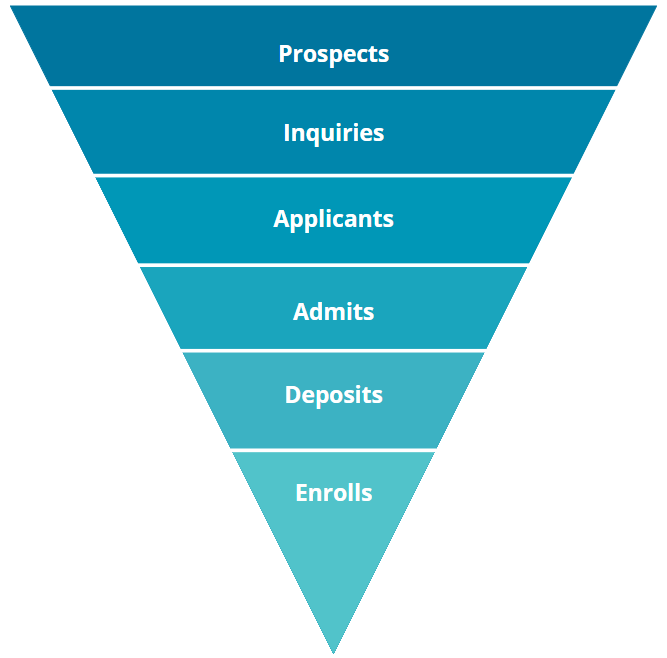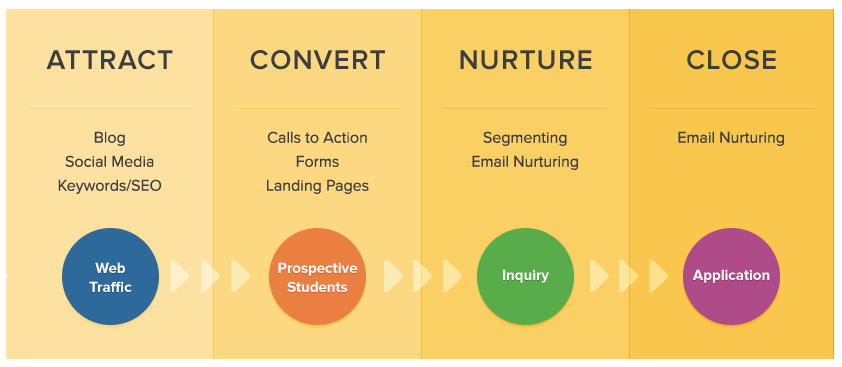
Written By:
Sean Henri
In today’s environment where students can find college-related information online with the click of a mouse, inbound marketing is a necessity for higher education as these prospective students become more informed. Inbound marketing for higher education will:
- Attract the right students and families to your website
- Convert these anonymous visitors into known prospects
- Turn these prospective students into new students
The job of the higher education marketer is more challenging than ever. Under the pressure of increased competition from peer institutions, rising tuition costs, and free or alternative forms of education, it’s no longer possible to do things the way it’s always been done. To survive in this competitive atmosphere and meet enrollment goals, many universities have discovered that they need to start acting more like their counterparts in the business world, and begin treating the enrollment funnel like a sales and marketing funnel. Students are now customers, and those customers have more power than ever.
When I think back to the days when I was still in high school, things were very different. We didn’t have search engines or social media to help find the best schools. Representatives from nearby universities would come visit our school and hold a small overview meeting with us in the guidance counselor’s office, and we all walked away with a thick folder jam-packed with bright colorful photos and information about life on campus. There was an 800+ “Best Colleges” guide that we could borrow from our teacher. The decision making process was heavily restricted to college fairs, what we received in the mail, or heard from our friends, teachers or family.
Free Toolkit – Create Student Personas For Your School
Today, students are much more in control. Instead of waiting for a college fair or for an admissions counselor to come calling, students turn to Google, YouTube and Facebook, where they now complete over 75% of their research. They’re researching academic options, career prospects, and getting a good feel for campus life. As of 2011, nearly 1 out of every 4 students completed their research exclusively online. You can bet that trend has only increased since then.
Prospective students and their families are online and asking questions. It’s your job to answer.
The Inbound Marketing Methodology for Higher Education
This is where inbound marketing comes in—or, what we like to call Inbound Enrollment. Traditional outbound marketing tactics like billboards, radio ads, printed mail, and viewbooks are still quite popular in higher education, but difficult to measure and hard to get directly in front of the right audience.
They’re also easier than ever to ignore. Back in the days of Don Draper, there were only a few mediums available to compete for people’s attention – radio, TV, and magazines. Today, these mediums remain quite strong – but they live alongside hundreds of additional channels that compete for attention. We have phones and tablets that allow us to multi-task, DVR’s and Roku’s that let us skip commercials, and connected devices that allow us to break from screens all together. It’s not a massive advertising budget that will help you cut through this noise. It’s value. You need to engage in the conversation by answering the questions your prospective students are asking, where they ask them, and when they ask them. Get students to come to you – not the other way around.
You’re probably used to an enrollment funnel that looks something like this:

The inbound marketing methodology divides that funnel into four stages which guide your marketing efforts: Attract, convert, nurture, and close. Let’s take a closer look at the inbound marketing methodology and how it can be used in higher education.

Attract: Bring the right prospective students and their families to your website.
Larger institutions with deeper pockets may easily be able to afford to pay $35-$100 per click, but is that something you really want to do when you can capture an organic click for free? What makes matter worse, is that not every click is going to convert. Most sites will see a conversion rate between 1-5%, which means to capture a single inquiry from a prospective student could cost you hundreds if not thousands per inquiry. Smaller institutions can’t even consider this type of scenario.
Inbound levels the playing field. By identifying your ideal prospective students and researching their journey towards selecting a degree program and institution, you can create accurate student personas which will allow you to tailor your content to your audience’s specific goals and needs. Then, you can create relevant and impactful content that attracts these students to your site through organic search.
Content plays a critical role in inbound marketing, especially in the awareness stage of the student journey. For example, blogging, SEO and social media are extremely effective ways of dominating search engines. It will take some time and a lot of effort, but the ROI is significantly greater when you eliminate the high cost-per-click averages of paid search. In fact, Hubspot found that schools that use inbound marketing methods are seven times more likely to report higher ROI than schools using outbound methods.
Not sure what to blog about? Here’s a few ideas:
- Case studies highlighting the career paths of alumni
- How to get the most out of a campus tour
- The best things to do for fun and recreation in the closest city
- How to leverage your college network to get a job
- Current research projects of faculty
- See 50 more blog topic ideas
Convert: Turn your anonymous visitors into known prospects.
Blogging and social media are fantastic ways to generate traffic from a relevant audience – but what do with them once you’ve got them there? You need to create a path to conversion.
Start by creating more in-depth content around a topic relevant to your audience. This can take the shape of a white paper, a guide, or a pre-recorded webinar. This high-value content should live behind a form on a landing page. This area is called a conversion point. Your blog posts, which attracted visitors to your site through organic search and social, should now lead those visitors down a conversion funnel that leads to this conversion point. If you’ve done a good job researching your audience and created something useful, your visitors will pay you back by providing their digital currency – their email address. Now you have something you can really begin to act on, which leads us to the next step.
Nurture & Close: Turn prospective students into applicants, and then into students.
With every new form submission, you’ve gradually built up an impressive email list. Now the real challenge begins! How can you start communicating with prospective students in a personalized manner that aligns closely with where they are in their research process?
The old way would be to pick up the phone and start writing personal emails on a case by case basis in a completely manual way. This may have worked if your admissions counselor wasn’t completely burnt out by the end of the month, but thanks to marketing automation, there’s now a much easier way.
Tools like HubSpot have enabled marketers to build automated email workflows to enable lead nurturing or “drip” campaigns that deliver content closely aligned with the leads needs, interests, and stage in their research process.
For example, a visitor who landed on a blog post about career options for Biologists might be placed in an email workflow that delivers content on choosing and selecting the best science schools, and eventually, if her digital body language implies she’s interested, encourage her to schedule a campus visit or apply.
Meanwhile, if she were to return to the website directly or through a search engine, her previous interactions would drive a personalized experience on the homepage that highlights the latest research efforts of the Biology faculty, stories of recent graduates, or available biology co-op opportunities.
Personalizing the student journey in such a way can allow you and your team to nurture a valuable relationship with the prospective student and help her make the decision to apply to your school and ultimately enroll.
Making The Shift to Inbound Enrollment
Making the shift away from outbound tactics towards inbound can take some time, but with a steady focus and baby steps towards your goals, higher-ed marketers can begin growing their inbound marketing funnel in no time. Start by talking to your recently admitted students. What frustrated them about their experience? What couldn’t they figure out along the way? Find a way to answer those questions online and you’ll soon transform the way your team does marketing.







